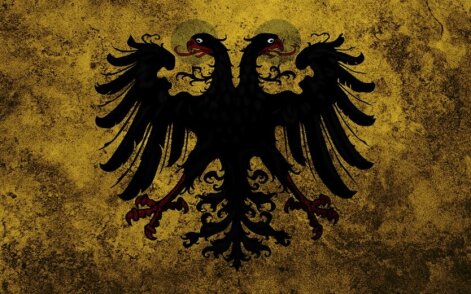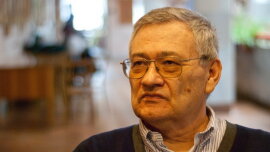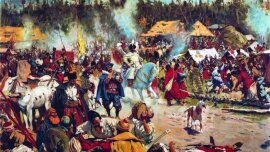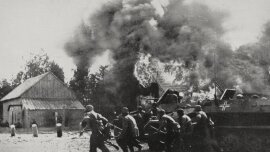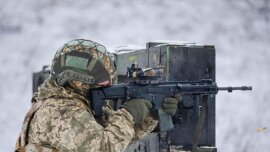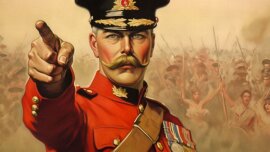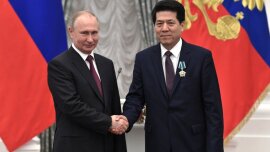Modern Russia, along with our internal Ukrainian, "authentic" lack of consolidation, social infantilism, anti-systemism and disorganization, as a state model, is certainly our real external enemy. First of all, Russia is a systemic enemy of Ukrainian statehood. Moreover, the enemy in all previous historical periods, including the modern one.
Based on the historical facts that have taken place in our history, I believe that the most important element in a long-term strategy of confrontation with the Russian Federation is a correct understanding of the motivation and characteristics of the enemy with which Ukraine is dealing. By the way, in their war with Ukraine, the Russians use the same Chinese rule - "in order to understand a problem, you first need to name it correctly."
I recommend reading a very simplified understanding of the nature of our humanitarian war with the Russian Federation for identity in my article on The Ukrainian Post
https://ukrainianpost.com/opinions/83-what-kind-of-war-is-russia-waging-with-ukraine-what-you-need-to-know-about-the-invasion-in-january-2022
In the mass consciousness of modern Ukrainians, there is a distorted and primitive idea of our eternal enemy, which prevents us from correctly understanding the essence of our confrontation with Russia and which the Kremlin itself is successfully using against us.
In Ukraine, due to the general state and social infantilism, the consciousness of society is overloaded with "political metaphysics" in relation to completely tangible and formidable factors. Increasingly, on-duty "molfars" of different caliber and different levels of primitivism are the "speakers" of our political programs and "political forecasts" that, they say, "Putin will die soon", Russia is "darkness", this is "a wild Mongolian horde of uneducated savages, and we are all Europeans here with Magdeburg rights", therefore Ukrainians, as "absolute light", in any case, will somehow defeat "absolute darkness". In other words, our eternal enemies will surely melt by themselves, "like dew on the sun." It simply cannot be otherwise.
Well, firstly, in history and real politics there is no "absolute light", as well as "absolute darkness", there is only our effective strategy or our defeat, which are the result of someone else's effective strategy. The failure of the Ruin era at the end of the 17th century, the stupid defeat of the Mazepa project at the beginning of the 18th century and the collapse of the UPR ( The Ukrainian People's Republic (UPR), or Ukrainian National Republic (UNR) - ed) in the first half of the 20th century are, first of all, a more effective strategy of Moscow, and not the intrigues of metaphysical "dark" forces.
Our childish myth about "light" that must defeat "darkness" is, of course, a naive simplification of the problem and infantile joking of the seriousness of the danger that Russia and its foreign policy actually represent.
Substrate
The Muscovy, the Russian Empire, the USSR or the modern Russian Federation represent one and the same state foundation, which, depending on the historical situation, changed its names, remaining unchanged and monolithic in the form of state administration, the principles of the construction of a social ideologeme and an expansionist worldview.
Russia is a continental-type empire with an 800-year tradition of its statehood, and when you hear flashy tales about the "horde", about "darkness" and "light", you need to clearly understand what actually lay at the basis of the formation of the Moscow (Russian) statehood, what is the source of its endogenous strength and what are the strengths of this state model. Understanding these basic, from my point of view, quite simple things, we can start a discussion about how to build a realistic stratagem of confrontation with the Kremlin for the possibility of preserving our Ukrainian sovereignty.
Start triggers
Purely technically, not only close and long-term interaction with the Golden Horde helped Moscow to exalt, but also indirectly Kyiv, which soon went into the Lithuanian state project, along with most of the territory of modern Ukraine. In 1299, the Khan of the Golden Horde Tokhta, having entered into a confrontation with the rebellious beklarbek Nogai, ruined the ulus (possession) of Nogai, which, by the way, included the entire Middle Dnieper region with Kyiv. According to the chronicle, after the storming of the city, "the whole of Kyiv was spread."
It was after this terrible devastation of Kyiv by Khan Tokhta in 1299 that Metropolitan Maxim of Kyiv transferred his residence, the so-called "seat" from Kyiv to Vladimir-on-Klyazma, in fact, displacing the "management administration" of the sacral center of clericalism in Russia from Kyiv that had lost its political significance to the northeast to the "capital city" of Zalesskaya Rus - Vladimir - that is, to the nearest orbit of the future expansion of Moscow. It was the first technical trigger.
"... in 1299, Metropolitan Maxim, unable to endure the violence of the Tatars, gathered with all his kliros and left Kyiv for Vladimir on Klyazma ...", which served as the beginning of Moscow's further acquisition of the significance of the clerical capital of Russia in the years of his successor, Metropolitan Peter. (c) Klyuchevsky
Another trigger, in the same 1299, was the transfer of a significant number of nobles with their "service people" from Kyiv devastated by the Tatars to the territory of the Moscow principality. This "relocation" immediately affected the increase in Moscow's military strength and its administrative potential. The routine need to provide for the maintenance of the increased number of "service people" became one of the reasons for the first systemic expansionist actions of the youngest son of Alexander Nevsky - Moscow Prince Daniel.
Survival stratagem
Being on the periphery of the Slavic world, surrounded by "friendly" principalities, having long contact with the nomadic steppe, with the Golden Horde, as with the territory of permanent and inexorable chaos, the small Moscow principality was forced to develop its own special survival strategy.
The stratagem consisted of several basic points:
1. The sacredness of the one-man and unquestioning vertical of the adoption of legitimate state decisions in matters of the internal and external political agenda.
2. The use of any available measures to eliminate the "territory of chaos" - the "nomadic steppe", as a dangerous frontier that threatens the subjectivity of the Moscow elites and the capital - Moscow.
3. Enlargement of its territory through expansion, in order to increase the "buffer zone" in contact with the "territory of chaos" and moving the frontier away from the capital - Moscow, and, consequently, from the elite.
4. Cultivation among the people of the worldview of the cult of aggressive expansion as an effective mechanism for protecting against the "territory of chaos" (the cult of war) and the creation of a pantheon of state victories.
5. The transformation of clerical institutions (churches) into de facto state institutions to create an ideologeme of sacrifice "protection from the territory of chaos" in the Orthodox "fortress of stability" and to maintain the sacredness of the one-man state vertical.
Consistently and systematically using this stratagem, starting with the princes Daniel, Vasily the Dark, Ivan Kalita, Dmitry Donskoy, maneuvering in the most difficult relations with the fading Golden Horde, Moscow diplomacy, intrigues, buying labels for reigning, continuous wars "for unification", until in 1478 the majority of the neighboring appanage principalities were subjected to its power, and after the destruction of the sovereignty of the veche Novgorod Republic, the Grand Duke of Moscow Ivan III was called "collector of Russian lands" and "sovereign of all Russia". By and large, all the points of the Moscow strategy of state functioning, institutionally, work to this day.
The sacredness of power as the basis for the legitimacy of decision-making
It should be noted that the clerical factor of the Orthodox Church, which today is successfully working for the nationwide stratagem of Moscow expansion, already at the end of the 15th century, wrote out a long-term concept of Moscow's sovereignty not as a historical "upstart", but as a "third Rome", based on the marriage of Ivan III and Sophia Palaiologos - niece of the last emperor of Byzantium Constantine XI Palaiologos.
The concept of the "third Rome" has become a convenient justification for the outflow of the "holiness" of one-man authority. "Continuation of the traditions of the lost Byzantium", which is a descendant of ancient Rome. The Moscow grand dukes, and later tsars, starting with the first officially crowned Ivan IV, became "direct descendants of the Roman Caesars and Orthodox emperors" of Constantinople in 1453, conquered by the Ottoman Turks.
In the popular consciousness of the Muscovites, this majestic construction of "preserving the holy heritage of the lost Byzantium in the tsars" becomes the foundation of the pseudo-Orthodox, "only true" expansionist philosophy of "defending" Moscow not only from the "chaos" of the East, but also from the "incomprehensible freedoms" of the West of the Latins, as ideological threat to the foundations of the state. Moreover, in the collective unconscious, the Byzantine concept becomes a confirmation of the “sacredness” (naturalness) of the vertical of power, which is very relevant in the context of the current, ongoing and seemingly “irrational” opposition of the Russian Federation to the collective West. It is not for nothing that in his letters to the Polish King Stephen Batory, Ivan IV already wrote: "you are an "elected" tsar - not a real one."
Patrimonial consciousness as a support for the vertical of power
"What pleases God, pleases the sovereign" (c) - this is how the Byzantine "cushion" of legitimacy determined the entire further institutional effectiveness of the Moscow power vertical. Moreover, it remains static regardless of the historical period of Russia, whether it is the kingdom of Mikhail Romanov, the empire of Peter the Great or Nicholas the First, the USSR from the time of the seminarian Stalin, who created a religious version of "Marxism" with "holy relics" in the Mausoleum, or the Russian Federation of modern President Putin. This is a rigid "monarchy of patrimonial consciousness", where all the people living on its territory are, as it were, "alien serfs" to the territory of the "king", who owns the land according to the "natural", sacred tradition of "power from God" and is the only pattern of "protection from chaos". Therefore, to argue with the vertical of power is to question the existence of the state. This is what the West, with its "incomprehensible freedoms", does not understand about Russia. During the time of Ivan IV (the Terrible), even the boyars in petitions wrote - "I am your serf", and for the first time the privileged class in Russia ceased to be "serfs" only in the 18th century, by decree of the "democrat" Emperor Peter III on "liberties to the nobility".
Efficiency of the survival stratagem
The effectiveness of the state stratagem in Russia is largely determined by the degree of cruelty of the power vertical. All periods when conditional "liberals" such as Boris Godunov, the impostor Grishka Otrepiev, Peter III, Paul I, Alexander II, Nicholas II, Khrushchev or Gorbachev appeared in the Kremlin led to a drop in the legitimacy of the vertical and, as a result, to confusion or "perestroika", threatening worldview disorganization, territorial and resource losses.
The turmoil or "thaw" in Russia is a constantly unlearned lesson of history, after which the Kremlin, reflecting the collective unconscious and rejecting the "classic" version of the development of the state, as the creation of comfortable living conditions for citizens, always returned the suppressor of turmoil , with an ax, camp gruel and a bullet strengthening the state vertical, directing it along the "irrational" but traditional stratagem of development of "protection from chaos." That is, in the direction of expansion.
Endogenous Forces of Strategy Development
In the process of Moscow's expansion to the north, south and east, a historical paradox worked - a colossal increase in the "frontier" and its sovereign territory, even after the "greatest geopolitical catastrophe" - the collapse of the Golden (or Great) Horde in 1480, "did not solve the problem of survival" .
Although the immediate external threat to the capital became significantly less, the vast expanses of "territory of chaos" in the east, north and southeast continued to exist and this forced Moscow, following the example of ancient Rome, to continue expansion in its "protection from chaos" stratagem through the conquest of new territories , the conquest of and ideological assimilation by "stability" of ethnically alien peoples - from the capture of Kazan and the "pacification" of the Cheremis to the conquest of Chukotka and from the conquest of the Caucasus to numerous bloody wars with the Ottoman Empire and Persia.
Thus, Moscow's expansionism, as the continuous export of the worldview of the "unique order" and the constant struggle against the "territory of chaos" became an end in itself. The subsequent emergence of already imperial geopolitical ambitions and the creation of spheres of influence by the method of "defense" through attack became the endogenous force of the Russian state strategy. Moreover, this “rough”, at first glance, method works, regardless of the historical period and the form of the ideologeme, whether it be militant Orthodoxy, Marxism, turned by the Russian Bolsheviks into a surrogate for religion, or Putin’s modern neo-imperial construct, built on resentment in relation to Western countries and the cult of "non-war" war.
Expansion limits
Historical facts testify that Moscow's expansion in their peculiar struggle against "chaos" stopped only where it was limited by force majeure circumstances in the form of geographical obstacles or in the form of state models with a high level of internal organization and the possibilities of their own political initiative. That is why expansion to the west was not as successful for Moscow as it was in the north, east and south, where in most cases, with the possible exception of China, Moscow dealt with dozens of ethnic groups that did not have stable statehood.
The western territory of multi-level and "elective" freedom has always been no less dangerous for the Moscow form of "one-chief stability" than the eastern "chaos frontier", however, Western state models had a higher level of social organization than the Astrakhan or Kazan Khanates, Yakuts, Chukchi, Uzbeks or the tribes of the northern Caucasus, so the expansion of Moscow to the west was, for objective reasons, much more slowly.
In those cases when a neighboring state model or an association of states showed a high level of social organization and subjectivity, Moscow could not pursue an effective policy of expansion. Weakened Livonia, which was attacked by Ivan IV (the Terrible) in 1558, was almost conquered by Moscow, however, faced with a well-organized force in the form of the Commonwealth and King Stefan Batory, the expansion had to be curtailed and soon the Moscow troops could hardly restrain the counter-expansion of the united Polish-Lithuanian state, eventually losing the twenty-five-year Livonian War and losing territories already conquered for a long historical period.
The territory of the Muscovite kingdom, as well as the territory of modern Ukraine, was open for a long time to regular and devastating campaigns of the Tatars of the Crimean Khanate - this fragment of the Golden Horde, which brought "chaos" from the southwest. For centuries, the Muscovites hid behind the "notch lines", paid tribute to the Crimean khans, and Khan Devlet Girey reached Moscow in the 16th century and burned it. The Crimean Khanate was a small state, but its army and vassal relations with the powerful expansionist Ottoman Empire politically strengthened the position of Bakhchisaray. For a very long time, it was the Crimean Tatars who were an important factor in the geopolitical influence of Istanbul on the Moscow kingdom. However, as soon as the Ottoman Empire weakened organizationally, the Russian Empire of Catherine II, as a result of two bloody wars, was able to carry out large-scale expansion to the south, occupying the Crimea, destroying the statehood of the Crimean Tatars, taking away the northern Black Sea region and entering the Kuban, laid the foundation for the subsequent Caucasian expansion of Moscow.
After the war with Sweden in 1808-1809, the Russians relatively easily, almost for more than a hundred years, took away all of Finland from the weakened Stockholm, including it in their political space, sending Sweden into the "auditorium of world geopolitics", however, in 1939-1940, the high state and public organization of Finnish society did not allow the Stalinist USSR to impose its understanding of "unique stability" on Finland. The Finns, by military method, having laid 150,000 Soviet soldiers in the frozen ground, vividly and very clearly showed Moscow the value of the material and resource price that would have to be paid for the fight against "chaos" on their territory. Having come into contact with reality, the pragmatist Stalin decided to stop the expansion for a while, concentrating on preparing for a "liberation campaign" in Europe. The subsequent "Finlandization" that took place after the Second World War also shows the correct understanding of reality by the pragmatic Finnish elite, who prioritized political sovereignty and the modern economically successful Finland is a confirmation of this "shameful" strategy.
The Commonwealth, at the height of the internal political crisis in the middle of the 17th century, caused by the gentry latifundism, which we usually call the “Khmelnitsky rebels”, lost its internal organization. As a result, it weakened and was defeated by Moscow. As a result of the war (1654-1667), the Commonwealth lost the Left-Bank Ukraine and Smolensk. Moreover, a little later, according to the Eternal Peace of 1686, for 146 thousand rubles, as compensation, the Moscow kingdom bought Kyiv from the Poles, which for a long time - until 1991 of the XX century, remained in the cultural, political and identity space of Moscow, as "mother Russian cities".
The Stalinist USSR in the 50s of the XX century, after the Second World War, continued to expand the horizon of the expansion of its influence in Eastern and even Central Europe, until it ran into tough response initiatives from the countries of the collective West. After Churchill's Fulton speech, an "iron curtain" grew in Europe from Kiel to Trieste and its embodiment was the Berlin Wall, which separated the two worlds. Moscow, which had expanded its "ideological" borders from North Korea and Communist China to Czechoslovakia and Germany, stopped only when the United States showed the threshold of the nuclear price of irreparable damage that the Kremlin would have to pay, and the "Caribbean crisis" became that "moment of truth" after which , for a while, Moscow slowed down its expansionist pressure of "unique stability."
Ukrainian pillars of identity
Since its successful expansion into the left-bank Ukraine in the middle of the 17th century, the Muscovite state has added to its expansion strategy of "unique stability" the idea of "reunification of Russian lands temporarily cut off from the umbilical cord" with Western models of "chaos of freedom." The Kremlin implemented this idea consistently from the partitions of Poland by Catherine II at the end of the 18th century, up to the partition of the Polish state carried out by Stalin and one "Austrian artist" at the end of the 30s of the 20th century, when Western Ukraine and Western Belarus entered the political space of the USSR .
For us today, it is extremely important to understand that from the point of view of the enemy, the territory and population of Ukraine is the "legally conquered", and "temporarily lost", "unifying" meaning of Russia, which is sacred for Moscow in the context of the very existence of the state. Kyiv is one of the pillars, along with Moscow, Vladimir, Novgorod, Minsk and St. Petersburg, which legitimize the "origins of identity", "common history" and the integrity of the basis of the East Slavic imperial construction. That is - "one nation", as grandfather Putin likes to say. As long as Kyiv is the capital of sovereign Ukraine, the Kremlin will continue the war with all available measures and will not stop at any losses in the process of expansion, up to the threat of "limited" use of nuclear weapons. Let you have not even a shadow of a doubt about it. Therefore, Lavrov, after rounds of negotiations with the United States, NATO and the OSCE, emphasized the message that:
"Russia has never threatened the Ukrainian people, unlike Zelenskyy and his associates" (c)
Lavrov's message is a standard imperial trick when the Russians are trying to incite a certain "suffering people" to a fight with a "criminal regime." With this phrase, the Russian Foreign Ministry, in fact, singles out the "Ukrainian people" as a separate object that needs to be "protected from chaos", depriving them of the opportunity to have their own "wrong" statehood. The Kremlin can threaten, allegedly, only "Zelenskyy and associates", that is, "illegitimate", "not sacred", "non-natural" organization of power.
Carrying out a complex process of destroying Ukrainian subjectivity, using all available measures in modern warfare, Putin consistently does not fight Ukrainians as an ethnic group, he wages war against even the hypothetical possibility of Ukrainians becoming (!) a political nation (!), having its own, distinct from Russia, a socio-political organization. Putin continues to implement the old stratagem of Moscow's survival - he is at war on the territory of Ukraine with the "chaos of freedom", promoting the expansion of "unique stability" to the West.
Let's learn with you to tell the truth at least to ourselves, even if it is unpleasant for us. Modern Ukraine, as a model, objectively, is a post-colonial state that does not have its own long-term traditions of sovereignty, with an extremely low, degraded social culture and, as a result, a catastrophically primitive form of political and state organization based on the redistribution of the remaining resources. It is for this reason that in Ukraine there is no stratagem of classical state development and its own state protection. Therefore, at the present historical moment, the Kremlin has not only a theoretical, but also an organizational and practical opportunity to carry out the desubjectivization of Ukraine for subsequent territorial expansion with a very high probability of success.
Thus, the limits of Moscow's territorial expansion or expansion of its geopolitical influence are:
1. The level of socio-political organization of state models of opponents
2. The ability of adversary state elites to take the initiative and build long-term defense strategies
3. Realized by the society of opponents the need to pay a resource price for sovereignty. Including, the human lives of its citizens.
The current countries of the collective West, despite the relatively high level of socio-political organization, have lost the motivation to expand the semantic ideas that are the basis of their socio-political contract. The lack of desire for expansion makes it impossible to develop an effective defense strategy, and as a result, gives rise to a loss of initiative. The Kremlin takes advantage of this by aggressively imposing its "realpolitik" initiatives and forcing its "partners" in Washington to act in a reactionary mode, bluffing and blackmailing Western politicians with "military-technical measures." The reactive "tactics" of imitation of "defense" and the fear of military measures, which are being demonstrated in Washington today, are strategically counterproductive and, with a high degree of probability, can lead to a significant surrender of the US positions, at least in Europe.
The cult of war and the pantheon of victories
"Russia has never attacked anyone. Russia has always defended itself." One of the important factors in Moscow's survival stratagem is the cult of war, which takes root among the people as a conscious necessity for the survival of the entire state model as a whole. The Russians, in contrast to our anti-systemic "quiet garden" worldview, where individual "cockchafers humming over cherries," are collective expansionists, where direct aggression is called "forced defense" from the "territory of chaos."
"I went off to fight
With a gun and a pack
So the poor in Granada
Could get the land back. " (a line from a Russian verse by Mikhail Svetlov - ed) Moscow needs a kind of verbal camouflage of aggression to justify the "exclusivity" of the national form of attack, as the "only possible" way out of the conflict situation, which the Kremlin defines as a threat to the main points of the survival stratagem. In all cases of state aggression, the clerical factor of the Moscow survival stratagem "sacralizes" the attack, bringing it to the level of "liberation", "salvation", sanctifying "sacrifice" in the name of victory and acting in most cases in sync with all state institutions. War is one of the main meanings in the worldview of the Russian people, as it is an effective mechanism for the implementation of one of the main points of the state survival stratagem - expansion.
For the cult of war to be effective, there must be no defeat in it. It is customary for us to mourn for Kruty and the Holodomor, to reflect on the defeat of Mazepa at Poltava, to cry about the victims of Baturin, to reopen the national wounds of Illovaisk and the defense of the Donetsk Airport. Moscow is following a fundamentally different path. The cult of war must be reinforced by a pantheon of victories and heroes who have become synonymous with these victories. Only then will it be effective. The entire official historiography of Russia is a series of almost continuous wars with big names of real and not so real heroes - from Alexander Nevsky, Dmitry Donskoy and Ivan Susanin to Denis Davydov, Minikh, Suvorov, Alexander Matrosov, Zoya Kosmodemyanskaya, Rokossovsky and Zhukov.
The official government in Russia, moreover, in all historical periods did not spare and does not spare huge funds not only for the monumentalization of their victories in the form of city names and the erection of monuments, but also for the creation of book, theatrical, cinematographic and gaming products that create an exaggerated halo of heroics "Russian war", whether it be the wars of the Distemper (or Vague time - the deep spiritual, economic, social and foreign policy crisis which has comprehended Russia at the end of XVI - the beginning of XVII century - ed.) of the 17th century, the conquests of Peter I, the Russian-Turkish wars of the 18th century, or an "unexpected" war with Hitler, carefully called Patriotic War by Stalin - with a very convenient allusion to the Patriotic War of the 19th century, when Emperor Alexander I expelled Napoleon's "chaos" from Russia.
Each war of Moscow for a Russian person is a natural and historical result of "defense", which increases the "national" territory of influence, pushing the "frontier of chaos" away from the capital. All defeats are "episodic" and are only a temporary respite for the subsequent revenge.
"I was buried in the globe..." (a line from a Russian verse by Sergey Orlov - ed). In Russia, no one lights "candles" on those who died in the war, the dead become "sacred" and at the same time "formal" sacrifice in the name of the highest state and collective task - the expansion of the worldview "stable unity." Death in the war in Russia is "ordinary" and Russian society, in the collective unconscious, agrees to endure sacrifice for the sake of state initiatives, in contrast to the Ukrainian society, where post-colonial anti-systemism and individualism, at a deep level, rejects the very fact of a possible violent physical death for the continued existence of a common state model as a construction alien to Ukrainians.
Many Russians in our country and in the West do not attach much importance to this feature of Russians, counting the number of "Russian coffins" in a possible large-scale escalation with Moscow. The pain "threshold" of corpses in Russian society is incommensurably higher due to the objective state and historical traditions we have described. I recommend that everyone carefully read the chronology of the Kremlin's Winter War with the Finns, get acquainted with the losses of the Soviet army during the Second World War, about the losses of the Russian Federation in the first Chechen war and realize the formula that is obvious to historians - for its state stratagem "fight against chaos" Moscow, as a state model, is consciously ready to pay with physical lives, both strangers and their own citizens.
Subtotals
We, of course, very schematically and briefly examined the main principles on which the state model of Russia - the enemy of our identity - is based. However, summing up these intermediate results, let's try to highlight the main thing:
The modern geopolitical strategy of the Russian Federation, as a state model, from the point of view of Moscow, is in a completely “rational” plane and, in general terms, does not differ from previous historical periods:
1. Continuous expansion of the worldview of "unique stability" as a long-term and systemic state strategy for protecting liberalism and democracy from the "territory of chaos". The established way of life of the Russian elite depends on this.
2. Increasing the sphere of its geopolitical influence and inflicting "acceptable" economic damage to Western countries, which principles and meanings of the socio-political organization threaten the collapse of the state model of the Russian Federation as a whole. The established way of life of the Russian elite depends on this.
3. Maximum preservation of the traditional principles of the structure of state administration within the country and in its sphere of geopolitical influence, based on a rigid "monarchist" vertical of unquestioning adoption of legitimate decisions regarding the domestic and foreign political agenda. The established way of life of the Russian elite and loyal elites in Moscow's sphere of influence depends on this.
The basis of the state structure of the Russian Federation are:
1. The principle of "sacredness" of the one-man power vertical as the foundation of statehood and a form of protection of society/elites from the "territory of chaos".
2. The "patrimonial consciousness" of the collectivist people, which is a support that legitimizes any state decisions of the power vertical, as an immutable and the only possible form of a social contract.
3. The cult of war as an ideologeme of the perceived need for a state strategy - the expansion of one's worldview.
The endogenous forces of Russia's "development" are the cruelty of the power vertical and the continuity of expansion. Only in the process of expansion Moscow acquires not only new resources, but also strengthens the vertical and the stratagem of survival as a whole, providing the elite with a comfortable way of life.
Managerial "liberalization" of the vertical slows down expansion. If the expansion is interrupted or loses momentum, in the long term, the Russian vertical of power, and therefore the elites, is threatened with a fall in internal legitimacy, and this threatens the state model of Russia with territorial and resource losses, which leads the model to unrest, "thaw" or revolution .
The limits of the expansion of the Russian Federation directly depend on:
1. The level of socio-political organization of its opponents' state models
2. The ability of adversary state elites to take the initiative and build long-term defense strategies
3. Awareness by the enemy society of the need to pay a resource price for its sovereignty. Including, the human lives of its citizens.
The strengths of modern Russia are
1. Working state institutions, cemented by a one-man power vertical, which makes it possible to significantly reduce the time between decision-making and its implementation.
2. Ability of the state system for long-term planning
3. Flexibility in the ability to build long-term and multi-level geopolitical strategies with their consistent implementation using all measures and possibilities of national influence.
4. The conscious readiness of the Russian Federation, as a state and social model, to pay a high price for the possibility of realizing the basic "irrational" goal - the expansion of the worldview of "unique stability".
This price is expressed in the amount of material and human resources that the Kremlin is ready to spend on the seemingly impractical "irrationality" in our large-scale confrontation with the West and for the restoration of "historical Russia" in the "post-Soviet space", which Putin constantly speaks openly about.
In reality, which we prefer not to notice, Russia currently has a clearly built self-identification of citizens, based on a historically justified algorithm for the survival of their state model, regardless of the ethnic culture of a particular individual. Russians, unlike us, clearly know who they are, what they are for and why they are for it. The possibility of destroying the state meanings of "undivided command expansion" is for Russians something for which they will pay a high price. The Kremlin has a rigid vertical of making and implementing its decisions. Moscow has the ability to build long-term, multi-level strategies and functioning institutions. To implement its basic expansion strategy, Russia has virtually unlimited resources, a working economy and a cult of war, with a constantly re-equipping army with updated combat experience in various hot spots on the planet from Syria, Mali and Libya to Chechnya and Donbas. Such is the reality. This is the enemy we are dealing with.
Often, Russians in Ukraine are called geopolitical "gopniks" (tramps - ed), "bears" in hats with earflaps and bast shoes, who, with the grace of an elephant in a china shop, "inexplicably" terrorize us and the "civilized world". Cultural, European and tolerant Ukraine, allegedly, should only wait until some kind of "civilized world" calms down the "irrational gopnik". This is how our state "strategy" of protection looks like to this day. Some even think that being in such a position, we will wait for a result that is convenient for our society - to sit quietly and it will pass somehow.
This is an extremely dangerous delusion, since modern Putin's Russia, being in the "china shop" of the rapidly changing "civilized world" and using the rude methods of "trading in horror", in fact, is implementing a very pragmatic and in its own way rational, long-term strategy of revenge and return to its historical sphere of geopolitical influence.
“I don’t know how it was with you, but with us not a single gun in Europe, without our permission, dared to fire out” (c)
These words, by the way, belong to an ethnic Ukrainian, a native of the city of Glukhov, one of the initiators of the partititions of the Commonwealth, Chancellor of the Russian Empire Alexander Bezborodko. XVIII century.
Using the internal contradictions and weaknesses of the consumer society, which is eating up the endogenous energy of the modern West, Russia is aggressively imposing its initiatives in reshaping the world layout, and the main Western actors have lost the initiative due to the lack of motivation to carry out further expansion of the liberal order. That is why we are now witnessing only a reaction from the United States in their desire to get away from the escalation of confrontation with the Russian Federation, not to pay a high price, to concentrate on solving their internal problems and the inevitable confrontation with China, in which they will obviously lose.
The Kremlin understands this very well and puts pressure on Western "vis-a-vises", habitually trading in the "horrors of war" in exchange for the return of geopolitical influence over the whole of Europe, the price of which, among other things, may be Ukrainian statehood, and the stubborn unwillingness of the "elites" and society in Ukraine to understand the seriousness and general contours of the Russian strategy makes futile even the discussion about building an effective Ukrainian stratagem of confrontation with Moscow.
